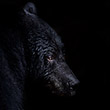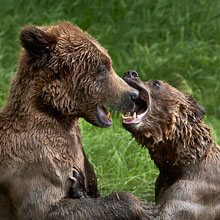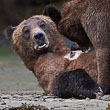Availability: Undetermined - Enquiries?
In the Field
Black on Black - Black Bear Emerging from Shadows. Northern BC Coast (Great Bear Rainforest), BC. September 29, 2009.
I find that capturing an interesting shot of a black bear is much more difficult than doing so with a grizzly bear, despite the fact that black bears are far more common and, in most situations, a little safer to approach. And, before the trip where I captured this shot I realized that I didn't have many black bear shots in my collection that I really liked. So...I decided that during my annual trip to the Great Bear Rainforest of northern British Columbia in autumn of 2009 one of my goals should be to capture some "different" and/or interesting shots of black bears (even though the intent of the trip was to find and photograph white-coloured Spirit Bears and grizzlies). Well, if nothing else, this shot is different!
One of my goals as a wildlife photographer is to capture images that transcend what I call "of a" images. "Of a's" are those shots which a viewer seems compelled to always add "of a XXX" when describing the shot, like "My, that's a nice shot of a bear". When someone simply says "Wow, what a beautiful shot" without adding "of a bear", I know I've succeeded. I know fully describing what I mean by "of a" shots is difficult - it's kind of like pornography - don't ask me to define it, but I know it when I see it! In a sense what I'm describing here is the difference between documentary wildlife photography and real wildlife art. Anyway...in reality I RARELY transcend the "of a" shots, but I think this shot just MIGHT come close! Only time will tell...
This image was captured under very low-light conditions. The bear was completely wet (from fishing in a stream) and the background (a creek bed full of dark coloured trees and rocks) was in deep shadow. I had to crank my ISO up quite high (ISO 2000) to give me manageable shutter speeds with the lens I was using and I knew that my image sensor's dynamic range would br pretty thin in this ISO range. It only took fairly faint light to illuminate this bear's wet head - the water reflected the light quite strongly. Given the relatively thin dynamic range I was working with I knew there was no way I could hold both highlight and shadow detail of this very high contrast scene, so I opted to REALLY lose shadow detail by under-exposing a lot (over 2 full stops). As I hoped, virtually everything in the frame - except a few portions of the bear - were lost to the shadows. And, I like how the bear seems to be emerging from the darkness. And, of course, I have to give the bear full credit for giving me this great pose!
This shot is NOT a product of heavy Photoshop manipulation. In fact, I used only exposure adjustments (and a little colour de-saturation of the too blue bear) that could have easily been accomplished in a dark room (back in the dark ages). You don't ALWAYS need to be a Photoshop guru to survive in today's era of digital photography!
ADDITIONAL NOTES:
1. This image - in all resolutions - is protected by copyright. I'm fine with personal uses of them (including use as desktop backgrounds or screensavers on your own computer), but unauthorized commercial use of the image is prohibited by law. Thanks in advance for respecting my copyright!
2. This image was captured during one of my autumn "Into the Great Bear Rainforest" photo tours in 2009. Each year I offer trips into two different parts of the Great Bear Rainforest as well as one to photograph marine mammals and oceanscapes near the northern tip of Vancouver Island. And, in selected years, I also offer photo tours to additional locations to capture other highly sought-after subjects, such as various boreal owl species, fishing grizzlies, and more. Details about these trips can be found on the Photo Tours page of this website.
3. Like all wildlife photographs on this website, this image was captured following the strict ethical guidelines described in The Wildlife FIRST! Principles of Photographer Conduct. I encourage all wildlife photographers to always put the welfare of their subjects above the value of their photographs.
Behind the Camera
Black on Black - Black Bear Emerging from Shadows. Northern BC Coast (Great Bear Rainforest), BC. September 29, 2009.
Digital Capture; Compressed RAW (NEF) 14-bit format; ISO 2000.
Nikon D3 with Nikkor 600 mm f/4G ED-IF AF-S VR lens - handheld. VR on and set to "Normal" mode.
1/160s @ f6.3; -2.33 stop compensation from matrix-metered exposure setting of camera.
At the Computer
Black on Black - Black Bear Emerging from Shadows. Northern BC Coast (Great Bear Rainforest), BC. September 29, 2009.
RAW Conversion to 16-bit TIFF, including first-pass/capture sharpening using Phase One's Capture One Pro 4.8. Three RAW conversions at different exposure settings. Exposure settings of -1.0 stops (for background) through to +0.74 stops (on various portions of the bear's head).
Further digital corrections on 16-bit TIFF file using Adobe's Photoshop CS4. Photoshop adjustments included compositing and masking of 3 exposure versions and selective desaturation of the body of the bear (to remove blue colour cast). No image sharpening or noise reduction after raw conversion.
Conservation
Black on Black - Black Bear Emerging from Shadows. Northern BC Coast (Great Bear Rainforest), BC. September 29, 2009.
Species Status in Canada*: Not currently listed as Threatened or Endangered.
This black bear is a member of the subspecies "Kermodei" (Ursus americana kermodei). This subspecies is unique in that the population is characterized by having an unusually high proportion of a recessive gene that produces white coat colour (found on the "Spirit Bears"). Because the Black Bear is not considered under threat as a species, both the Kermodei subspecies and the very rare Spirit Bear suffer from having the same conservation designation (it should be acknowledged that in British Columbia - the jurisdiction of greatest Spirit Bear abundance - hunting of these white-coated bears is not permitted). For reasons that are not fully understood, the Spirit Bear occurs with greater frequency in a relatively small geographic area within The Great Bear Rainforest of the central and northern coast of British Columbia. In this area 10 to 30% of the bears possess white coats. Many of the black-coloured Black Bears in this region carry the gene for white coats, so allowing hunting of ANY Black Bears in this region can reduce the frequency of the gene for white coats. Thus, to protect the Spirit Bear, it is necessary to prohibit the hunting of ALL Black Bears in this region. And, very unfortunately, the globally unique ecosystem that contains the Spirit Bear is under development pressure, especially from the forestry industry. If this unique environment is altered, we may lose the wonderful genetic anomaly known as the Spirit Bear forever.
*as determined by COSEWIC: The Committee on the Status of Endangered Wildlife in Canada

























